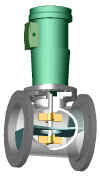This is a continuation of the
Process Intensifier - Optimization with CFD: Part 1 paper.
Analysis of Existing Dynamic Pipeline Mixers or Line Blenders
by
Pete Csiszar
, Black & Baird Ltd., North Vancouver, B.C.
Keith Johnson,
Independent Consultant, North Canton, Oh
Thomas Post, Post Mixing Optimization and Solutions, Pittsford,
NY
Abstract
 More and more processes require
intense agitation to achieve micromixing to minimize unwanted
byproducts and improve selectivity. If this were done in conventional
mixing tanks, the size of the
agitation equipment would be prohibitively large in regard to size
and cost. Most processes requiring process intensification require
this high degree of agitation only for a short period of time.
More and more processes require
intense agitation to achieve micromixing to minimize unwanted
byproducts and improve selectivity. If this were done in conventional
mixing tanks, the size of the
agitation equipment would be prohibitively large in regard to size
and cost. Most processes requiring process intensification require
this high degree of agitation only for a short period of time.
An ideal application is therefore mixing in a horizontal pipe.
The disadvantage of static mixers is the lack of degrees of freedom.
It is often impractical to alter the volumetric flow rate to
achieve various degrees of agitation or the addition or subtraction
of mixing elements. Dynamic pipe mixers allow for the alteration
of impeller speed and therefore the degree of mixing can be
accomplished without altering the volumetric flow rate through the
pipe. Another advantage is that it is relatively simple to remove
a dynamic mixer and change the impeller type. The length of the
pipe section is neither increased nor decreased, as it would be for
the static mixer.
An in-depth Internet search yields only three manufactures of
line blenders or in-line mixers: Lightnin, Hayward Gordon, and
Plenty. Of these three, Plenty does not elaborate what is inside
the pipe. From brochures and Internet descriptions, we were able
to construct four commercially available dynamic pipe mixers, which
we will call forthwith Process Intensifiers. They had both
radial
and
axial impellers.
In Part 1, we describe the design of these four Process
Intensifiers. Using CFD
as our experimental laboratory, we put each of these to the test
by studying how well they can agitate the fluid in a nominal
10" Schedule 40 pipe
flowing at 1100 GPM or 250 m3/hr. Velocity profiles,
flow patterns, tracer
studies, pressure distributions, shear rates, power numbers, power,
and resident time distributions are determined. Investigation of the
CFD outputs
shows "flow-flooded" impellers, dead-zones,
excessive recirculation and poor residence time
distributions. Suggestions on improving these designs are made.
In Part 2, we show how we took this knowledge and created
an optimized Process Intensifier by focusing on minimizing
the dead-zones, achieving a good residence time distribution,
and creating new internals and a new
impeller design
which controls the flow in the locally intense mixing volume.
Continue with the Introduction
or Go back to the Title Page
|
